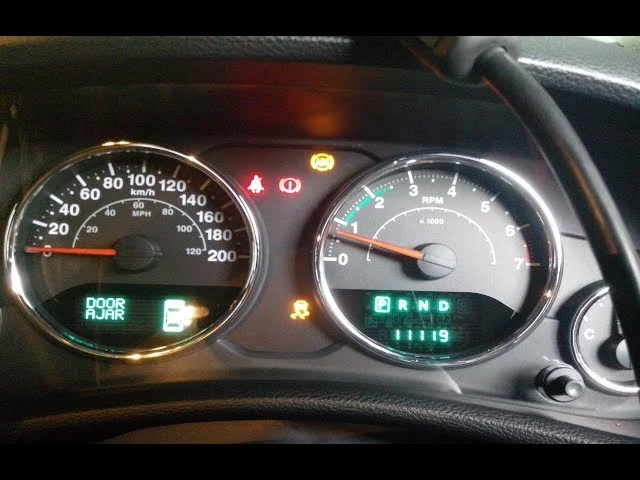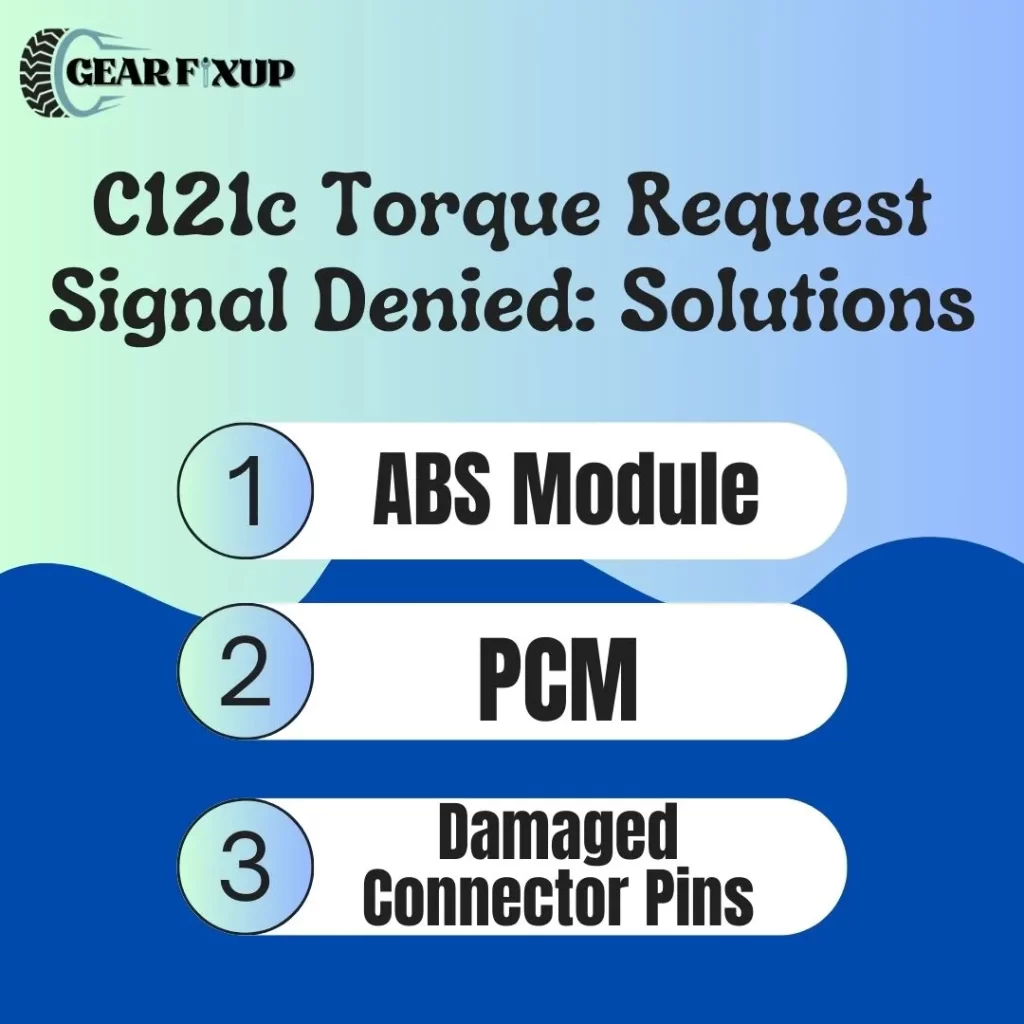Your vehicle’s dashboard shows a “C121c Torque Request Signal Denied” alert. What does this mean? There is no need to feel alone.
The first time you see an error code or alert can be confusing. The important thing is how you handle these messages and eliminate them in the future.

We will walk you through the C121c Torque Request Signal Denied alert message in this guide. The cause of this error code as well as some methods for determining the problem yourself will be discussed. For more information about removing these error codes from your computer, keep reading.
What Does the “C121c Code” Mean?
In the case that you have already communicated your message to the ABS module and it has already performed all necessary functions to determine that there is a problem with the system, which is hindering the activity of the traction control system, the C121c Code will appear on your system’s screen.
Thus, you will also see an alert displaying that the torque signal request has been denied for C121c.
How does the C121c Torque Request Signal Denied Alert occur?
No worries if you haven’t seen the “C121c Torque Request Signal Denied” error message before and don’t know what it means; we’ve got you covered.
There are two major reasons why this alert message could appear on your system’s screen. Here is a detailed explanation of both.
Anti-lock brake module problem

There may be a problem with your anti-lock brake module that is causing this alert message to appear. It is a microprocessor that controls the Anti-Lock Brake Module on your vehicle.
As part of the diagnostic process, it examines your vehicle’s anti-lock braking system and collects data from the hydraulic brake system as well as the wheel sensors. In order to determine when to release the brake pressure without pushing the car into skidding motion, the car needs to be locked at the right time.
A malfunctioning ABS control module will, however, prevent the traction control system from doing its job correctly, leading to the appearance of an “C121c Torque Request Signal Denied” warning.
Powertrain Control Module Issue
The PowerTrain Control Module (PCM) of your vehicle may also be the culprit behind the appearance of this alert message on your screen.
With the data it receives from a variety of sensors located at various places on your vehicle, the PCM controls the engine, transmission, and other vehicle systems. You may experience problems with the PCM even if just one of these systems or sensors isn’t working properly.
When this happens, your car’s traction control system malfunctions, resulting in an error alert appearing on your car’s dashboard.
Reasons For C121c Torque Request Signal Denied
It’s still difficult to determine what the actual cause of the problem is, even though both reasons stated above are the underlying causes of the C121c alert message on the system. You can determine the problem using these three simple methods.
DTC check
To determine if an ABS module problem is causing the error message, follow these steps.
To determine whether the ABS module was the problem, you can now monitor the ESP Torque Request status.
PowerTrain DTCS check
The procedure for recording Powertrain DTCs is exactly the same as method 1. By doing this, you can determine if the alert message appears on your vehicle due to a problem with the Powertrain module.
ESP Torque Request Signal Check
To diagnose the C121c Code error on your computer, follow these steps:
C121c Torque Request Signal Denied: Solutions
Let’s take you toward the fixes now that you’re aware of the causes and two ways to determine the actual reason for the alert message.

ABS Module
In order to fix the error message, you should first try to fix the ABS module, which is one of the primary reasons you see this alert message.
In regards to repairing the ABS module, it is a complicated procedure that cannot be performed on your own. For this reason, professional assistance is crucial.
Two main components of an ABS module comprise a control module and wheel speed sensors. It will cost you approximately $1,500 to $3,000 to replace both of these parts.
Fortunately, you don’t need professional help to replace the ABS control module. If you’re interested in learning how to replace the ABS control module, here’s a YouTube video guide you may find helpful. By doing so, you will be able to save money on replacements.
PCM
Secondly, the Powertrain Control Module may not be working properly, which may lead to the error message “C121c Torque Request Signal Denied”. Your first step should be to take your vehicle to a nearby garage and get the PCM of your vehicle checked if you have already determined that PCM damage is the main cause of this error message alert.
We cannot emphasize enough how important it is to repair the PCM before considering a replacement. This is due to the fact that more than 50% of the Powertrain Control Modules that were replaced needed some work. Repair the PC module by consulting a trustworthy mechanic.
Damaged Connector Pins
It may also be necessary for you to check the connector pins for any damage in order to remove the error message from the display of your system. In most cases, the traction control system is prevented from working by bent or corroded connector pins, leading to the C121c error message.
Hence, before giving up, make sure the connector pins are all in good shape and replace them if they seem worn out.
What is the cost of diagnosing code C121c?
There is no one-size-fits-all formula for determining the cost of diagnosing Code C121c, because it varies based on several factors, including the make and model of your vehicle, your local labor rates, and the extent of the diagnostic process. An hourly rate can range from $80 to $150 for professional automotive diagnostic services.
It may be necessary to buy specialized equipment and conduct in-depth analysis of the problem to determine the cost. It is also important to factor in potential expenses incurred as a result of repairs or part replacements.
Providing your vehicle’s details and the observed symptoms to your local auto repair shop will help you obtain an accurate estimate. Code C121c diagnostic costs can thus be more precisely assessed.
Why Do Fault Codes Exist?
Onboard computers generate fault codes that pinpoint abnormalities in various components of a vehicle, also known as Diagnostic Trouble Codes (DTCs).
A vehicle’s diagnostic codes provide insight into performance issues and are an integral part of modern vehicle diagnostics.
An irregularity detected by a sensor throughout the vehicle’s system triggers a fault code to be generated.
These codes can be retrieved from a vehicle’s computer using specialized tools, such as OBD-II scanners.
Coding enables systematic identification of problems during diagnostics. Each code represents a particular malfunction or problem.
What does C121C mean on a Mitsubishi Outlander?
An EBCM (Electronic Brake Control Module) or ABS (Anti-Lock Braking System) failure can result in the C121C code on a Mitsubishi Outlander. In particular, C121C indicates that a Torque Request Denied Signal has occurred.
The ABS module is crucial for handling the antilock braking system and traction control of the vehicle and often displays this code when it’s malfunctioning. Vehicle stability and safety can be compromised by ABS module problems.

An OBD-II scanner should be used to diagnose the C121C code in order to pinpoint the exact cause and solution.
To determine the necessary repairs or adjustments to resolve the issue, more detailed information on the specific conditions of the code must be obtained.
You should seek the assistance of a qualified mechanic if you are unfamiliar with automotive diagnostics.
Is there a way to fix code U1424?
Vehicle Dynamic Control (VDC) has a communication issue that causes the U1424 code. As a component of the vehicle’s stability control system, this module plays a crucial role. U1424 can be resolved by taking the following steps:

Scan Diagnostics
You can perform an OBD-II scan to verify the specific conditions that triggered the U1424 code using an OBD-II scanner. By doing so, it will be possible to identify the root cause of the problem.
Check the wiring and connections
Make sure the VDC module’s wiring and connections are correct. You should inspect the wires for corrosion, loose connections, or damaged wires. Maintain a clean, debris-free environment around all connections.
Verify power supply
Check that the VDC module receives the right amount of power. Be sure to check the fuses associated with stability control. If there are any blown fuses, replace them.
Check the VDC module
You might consider inspecting the VDC module itself if the wiring and connections are in good condition. Make sure there are no signs of damage or malfunction. The VDC module may need to be replaced if any issues are identified.
Professional Assistance
It’s advisable to seek professional assistance if you are unable to diagnose and repair a vehicle, or if the problem persists after basic checks. Repairs or replacements can be recommended by a qualified mechanic or dealership service center.
Read: Low Washer Fluid Light Won’t Turn Off – Reasons & Fixes!
Read: What Does KWP2000 Code Mean In Vehicles?
Read: How To Change 5.3l Lifters Without Removing Heads?
Read: Service Theft Deterrent System Reasons And Solution
Frequently Asked Questions
What is the best way to clear my engine error code?
The OBD-II scanner can be used to remove engine error codes. You can reset the codes by connecting the scanner to the OBD-II port of the vehicle, choosing the code clearing option, and following the prompts. Preventing recurring issues requires addressing the underlying issue before clearing codes.
What is the process for clearing permanent trouble codes?
Repairing the underlying issue is usually necessary to clear permanent trouble codes. A simple OBD-II scanner is usually all that is needed to clear the codes once the repairs have been completed.
What is the transmission control module error code?
Depending on the model and make of the vehicle, the specific error code for the transmission control module may vary. A common transmission problem code is P0700, which indicates a malfunction of the transmission control system, as well as specific P0xxx codes that indicate transmission problems. Use an OBD-II scanner or your vehicle’s service manual to determine the correct code.
What happens if you disconnect the battery and then reconnect it?
When the battery is disconnected, the check engine light may be reset, but the underlying problem will not be fixed. It is likely that the light will return if the root cause of the problem persists after reconnecting the battery. Before attempting to clear the check engine light, it’s recommended to diagnose and fix the problem.
How safe is it to clear engine codes?
Engine codes can be cleared safely, but the underlying problem must be addressed first. In the event that you clear the codes without resolving the problem, you may experience persistence or recurring problems in the future. In order to prevent ongoing issues, make sure you have made the necessary repairs before clearing the codes.
When do engine codes reset?
In some cases, it may take several drive cycles for the vehicle’s computer to complete the necessary self-checks after the underlying issue is resolved and the codes are cleared with an OBD-II scanner. Before completely resetting the system, the computer evaluates the health of the system through a range of driving conditions.
Conclusion
As we discussed in this guide, there are a number of causes of the error message C121c that appears on your vehicle’s computer system. Besides giving you some methods to diagnose the problem, we’ve also given you some advice on how to resolve it.
Our final point is to point out some fixes that you could try if you want to remove the error alert. You should no longer be concerned about seeing errors on your screen as a result of reading this guide.

![ECU 128 Code Freightliner [What Is It & Causes]](https://gearfixup.com/wp-content/uploads/2024/01/ECU-128-Code-Freightliner-What-Is-It-Causes-150x150.webp)

![Renault Braking System Fault [Meaning & Solution]](https://gearfixup.com/wp-content/uploads/2024/01/Renault-Braking-System-Fault-Meaning-Solution-150x150.webp)
